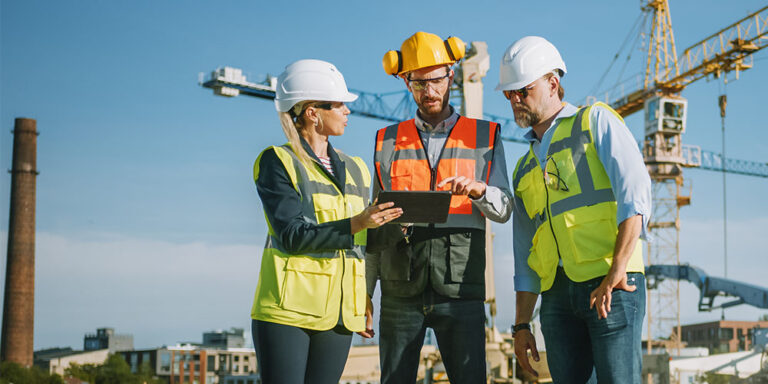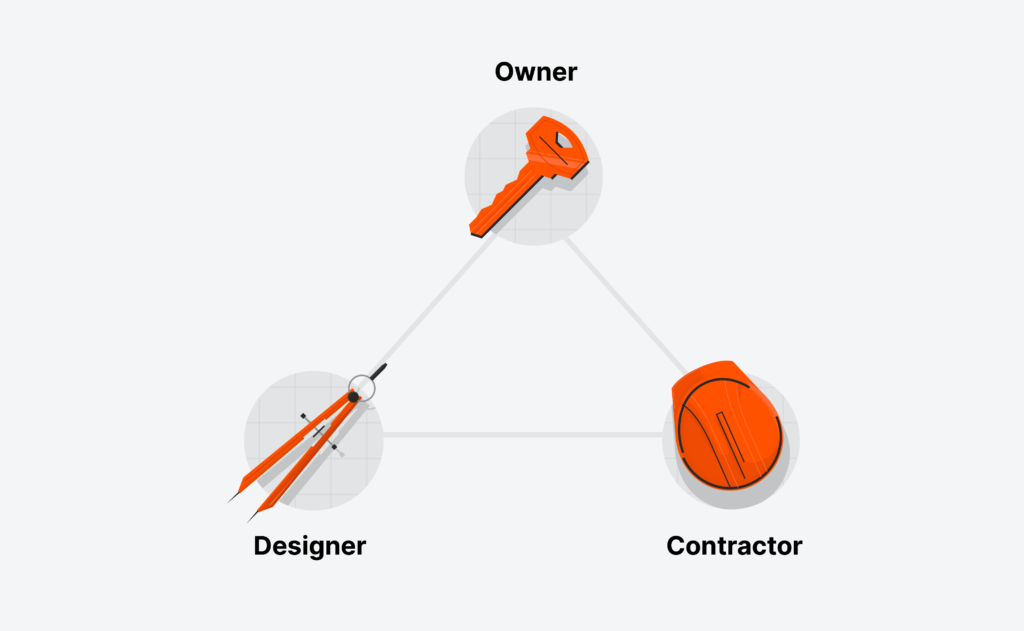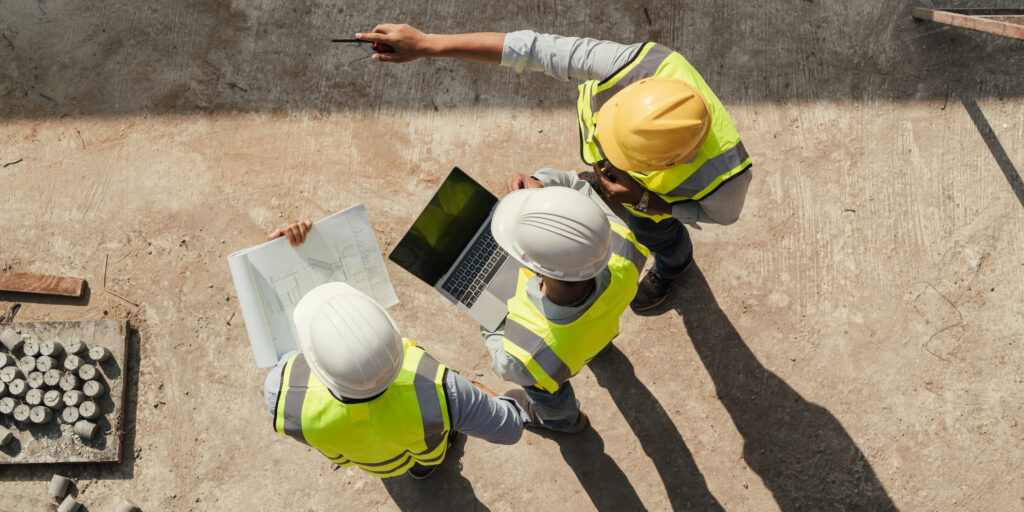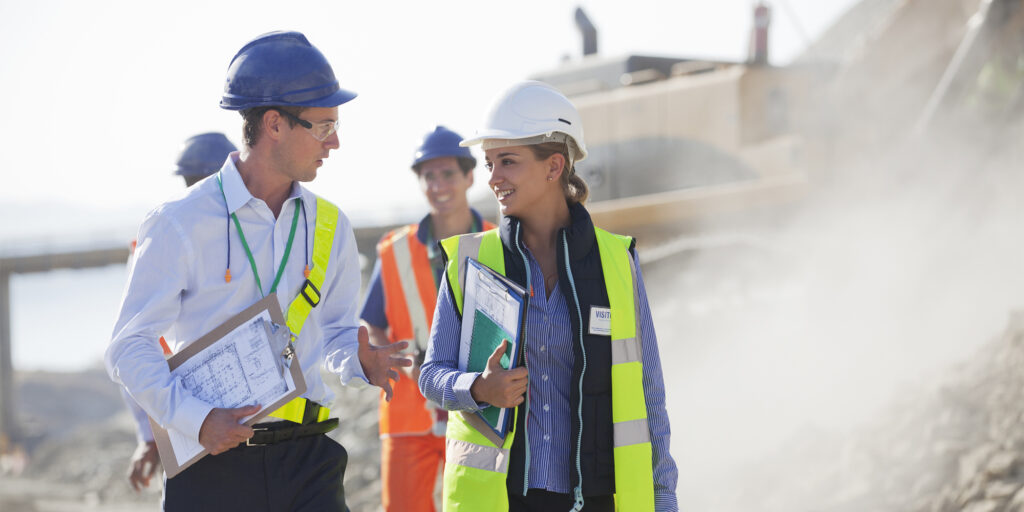— 12 min read
Inside the Construction Project Team
Last Updated Mar 11, 2025
Last Updated Mar 11, 2025

While steel and concrete may be the most visible elements of construction, people are the true core of every project. Teamwork is vital in the construction industry, especially for the construction project team responsible for managing the complex and distinct aspects of modern construction processes.
The construction project team is a diverse set of experts who come together to plan, design, execute and manage a construction project from inception to completion. This article will explore construction project team roles and the methods of collaboration that can underpin the success of the team. It will also offer tips on working well with the variety of personalities and specializations that come to the table to realize a construction project.
Table of contents
Construction Project Team Members
The primary project team members come from three basic groups: the owners, the design team, and the general contractor. Each group contributes essential team members, but the exact roles and contractual relationships can vary on each project, often determined by the project delivery method.

The project owner’s staff may be less involved in the day-to-day work of the project, or they might have a construction manager who is very engaged in operations, yet the owner will need to be involved in all critical decisions made by the team.
The design team can consist of architects, engineers, and other design professionals, and these professionals may come from more than one company to execute the specifics of a large project.
The general contractor’s team includes not just project managers and site superintendents but also safety, data, and compliance managers. The general contractor generally hires and manages the subcontractors, who can also be key players on the team.
Project Team Structure
Each project will have a unique project team organizational chart, but it is always important to approach teamwork as a collaboration rather than a strict hierarchy. However, there are individual project team members responsible for sign-off on specific actions, and knowing and respecting the chain of authority is important for efficient operations.
C-suite executives from the GC need to sign off on significant cash outlays or project changes. Although they spend much of their time in the office, many also visit the site frequently, which can significantly improve morale for workers.
The ownership company’s team also has sign-off authority over changes and needs to be kept in the loop on operations and issues affecting the build. Some owners have facility or construction managers who work more closely with the general contractor, while others have less involvement in daily operations.
The project manager is in the center of the entire project, coordinating work with design teams, the executive officers, safety, and site managers. Site superintendents are the primary authority on site, overseeing forepersons, subcontractors, deliveries and visitors to the construction site. Within the subgroups, foremen, architects, engineers, and other managers will be the prominent participants in the project team, overseeing those who work in their particular areas of the process.
Pro Tip
Interacting With Every Team Member
A more inclusive idea of the “project team” can include every single worker on-site as well as the back-office staff of every company working on the project. While there may be a hierarchy of responsibility, treating each worker with care and respect — from the person sweeping the floor to the project owner — can help them feel they are part of the larger team.
A case in point is how superintendents and other managers treat laborers on site. A worker may overhear a discussion that crew members wouldn’t say in front of the superintendent, but with a good working relationship, that worker may share important information with the super.
The cleaning crew notices the details of what goes on in the field, and they may report inconsistencies, flaws or other anomalies to a site manager they trust, which can help the team catch problems early on. Respecting and developing rapport and collaboration with every worker can pay off in terms of the respect workers will show toward managers and the enthusiasm workers exhibit for contributing to the project’s success.
Central Roles on the Project Team
Each project is unique, but most project teams include people in the following roles.
Owner or Owner’s Rep
The project owner or client is the individual, business entity, or organization that contracts for a construction project. The owner has legal authority, oversees, and usually funds the project. Clients sometimes have dedicated construction or facility professionals on staff. C-level executives within a client organization will be involved in major decisions on the project, as their money and property are at stake.
Architects and Designers
Architects and designers conceptualize, design the visual and structural elements, and develop the plans for a construction project. They work with engineers and the general contractor to ensure the construction drawings are realized, help with scheduling and approving submittals, and provide support throughout construction to assist in quality control. Architects also respond and help resolve issues raised in RFIs.
Project Manager (PM)
The project manager is involved from early in a project, planning and overseeing pre-construction through closeout. PM responsibilities include ensuring that the project stays on schedule and within budget, that all teams have what they need to perform work, communicating and boosting collaboration, overseeing site safety and quality control, and interacting with the client. PMs are usually members of the general contractor’s staff.
Engineers
Construction teams employ various types of engineers who design, plan, and oversee the implementation of construction, often including material selection, scheduling, and verifying quality. These include civil, structural, electrical, mechanical, and environmental engineers, who collaborate with architects, project managers, and superintendents to ensure the project's success.
Construction Manager
Though not present on every project, a construction manager (or sometimes the owner’s rep) can help to minimize risk by overseeing the project budget, schedule, and quality to ensure the project is successfully delivered. Construction managers have some similar duties to project managers, but they are typically hired by — and serve the interests of — the project owner rather than the GC.
Site Superintendent
The site superintendent is in charge of the daily activities on the job site, ensuring that crews have everything they need, scheduling work, maintaining quality and safety, and planning for people and supplies to flow smoothly and productively to complete the project. Superintendents oversee subcontractors, foremen, workers, and deliveries, and work closely with PMs.
Foremen
General contractors typically hire and oversee subcontractors, often also called trade partners, to perform work such as HVAC, concrete, or roofing on a project. The subcontractor’s foreperson is a key member of the project team, using their expertise to oversee their crews and ensure quality control. On some large commercial projects, the GC employs a general foreman to oversee all the specialty foremen.
Cost Estimator
Estimators are crucial in the bidding and preconstruction phases of a project. They determine the costs for materials, labor, insurance, and permits and help the general contractor submit a competitive bid to win the project while protecting the company's profits.
Health and Safety Officers
Construction is inherently risky, and safety managers develop plans and oversee safety on site to ensure compliance with laws and company policies to mitigate the risk of harm to workers.
BIM Manager
With the increasing centrality of building information modeling systems, a BIM Manager updates and utilizes the information to detect clashes and resolve changes. Some companies have construction information managers who may coordinate hardware and software to facilitate the seamless use of technology.
Organizing the Project Team
The project manager often organizes the team, spending time both in the office and on-site, and connects with all the other players to keep the team functioning productively.
Project managers need excellent people skills and the ability to build strong relationships with the wide variety of personalities they interact with. Large projects may have multiple project managers under one senior project manager, and the PM’s team is responsible for coordinating the many stakeholders and teams.
Other Construction Project Team Members
Numerous other team members can play essential roles on certain projects. A supplier of custom fabricated materials may be a crucial partner on an innovative structure, becoming involved in meetings about schedules and technical details.
For a hospital construction project, the owner may want to bring in key medical specialists to ensure that expensive equipment will have a functional built environment in which to operate.
Pro Tip
Diverse Personalities in Different Roles
Communication and collaboration are fundamental to the smooth functioning of a project team. Team members on each project have a wide variety of specializations and backgrounds. While some workers have a college education, others bring valuable years of experience on worksites, and have vastly different communication styles.
Today’s construction project teams require managers, especially project managers and site superintendents, to cultivate the people skills to positively communicate with various personality types and specialties. While technology aids more formal communication in construction, the personal connections created in the field can be invaluable for project managers.
In one example, the project manager needed to talk to a highly technical AV manager, yet other crew members warned the PM off, stating that this person didn’t like to interact. The PM then approached the AV person, noticing they had similar tattoos, and was able to make a connection and start a conversation, thus more easily communicating about worksite issues.
Small talk and common courtesy when approaching diverse workers can build bridges that allow for productive collaboration among different teams on the site or in the office.
Collaboration Amongst Project Team Members
When there is an atmosphere of trust between members of the project team, collaboration, which involves transparency and information sharing, is a byproduct. Developing trust for a project team involves starting early, involving stakeholders in meetings, listening carefully, and offering respect to every member of the larger team.
Building a rapport with people in disparate roles requires clear and honest communication, empathy, and a desire to understand the needs of each team member and work together to solve problems. Project managers can model respectful listening and help resolve conflicts to lower the tension in meetings where disparate specialists are under pressure to realize a complex project together.
A robust technological communication platform can facilitate collaboration. Technology can function to assist every department in tracking and managing detailed messages about scheduling, change orders, problems on-site, and more. During preconstruction, BIM and clash detection can proactively prevent site issues down the line. During the build, the BIM manager is responsible for updating the model and address clashes as changes are made during construction.
The visualization possible through this technology can also motivate teams by helping them understand and take pride in the finished project. In one commercial building, a client’s request for CGI images of the intended completed office prompted the project manager to display prints of the renderings on site. The ownership team was impressed, but even workers installing carpet and building walls found the CGI images inspiring.
Changing Times for Project Teams
Construction environments can be colorful, with workers prone to cursing and tempers that can flare. The “old school” construction teams had managers who chewed out workers for errors and an authoritarian top-down hierarchy.
The broader culture has changed, and the culture of construction teams has also advanced. The era of collaboration rather than competition is boosting productivity and civility on job sites and in meetings. In an era of labor shortages in construction, it is more important than ever for managers to show empathy, for the workplace to be productive, rewarding, and motivating, and for workers to feel respected and valued.
While the construction workplace is changing, older generations of workers still on site are used to the older ways and may need help adapting to new communication styles. In addition, the variety of people of all genders, cultural backgrounds, ages, and work histories come together in construction and need to work together. Managing project teams to encourage collaboration is challenging but necessary.
Technology cannot replace the personal interactions that cement positive workplace relationships, but it can enhance team communication and make it easier to discuss details with a record of the communication. With technology, the origin of errors is more easily found, and shifting from a blame perspective to one where team members can take responsibility for mistakes and work collectively to solve problems can enrich collaboration.
Best Practices for Construction Project Team Management
Many different managers in charge of distinct domains of the project come together to form the project team, and working together well is everyone’s job. However, project managers often have the task of keeping communication flowing between the key members of project teams, so managing the teamwork frequently falls to PMs. Here are some quick tips to support a collaborative and productive project team.
Choose skilled team members.
All team members will have some responsibility to contribute and lead different aspects of the project — so choose wisely.
Start collaboration early.
Building a culture of collaboration as soon as possible allows all team members to contribute to effective planning.
Practice honest and open communication.
Keep everyone informed of problems as they arise so all members can support solutions.
Build positive relationships.
Build relationships both on the construction site and in the office by welcoming input from all workers, rewarding small accomplishments and treating every worker as a human being.
Share 'ownership' of the project.
Make team members feel like a part of the team working together toward the common goal of a successful project delivery.
Don’t share every problem with everyone.
Burdening workers with possible future problems can unnecessarily draw focus away from the tasks at hand. Directors and managers may be able to resolve the issue proactively, and if not, share the information only when team members can take action to solve the problem.
Teamwork drives construction.
Every individual on the project team has a unique role to play, and orchestrating the team to integrate their expertise, hard work, and cooperation can create a more efficient and pleasant work environment.
Teams that collaborate and communicate well are crucial to managing the complex nature of modern construction projects and minimizing errors for less stressful, more profitable project completion.
Was this article helpful?
Thank you for your submission.
75%
25%
You voted that this article was . Was this a mistake? If so, change your vote here.
Scroll less, learn more about construction.
Subscribe to The Blueprint, Procore’s construction newsletter, to get content from industry experts delivered straight to your inbox.
By clicking this button, you agree to our Privacy Notice and Terms of Service.
Categories:
Tags:
Written by
Daniel Kavanagh
15 articles
Daniel Kavanagh is a Senior Strategic Product Consultant at Procore, based in Dublin, Ireland. Daniel is a results-oriented project manager with a passion for building relationships and exceeding client and management expectations, with career experience in project management, systems implementation, technical design and architectural finishes. Daniel has been a member of the construction industry since 2014, and graduated from the Carlow Institute of technology.
View profileJulia Tell
45 articles
Julia Tell is a freelance writer covering education, construction, healthcare, and digital transformation. She holds a Ph.D. in Media & Communications and has written for publications including Business Insider, GoodRx, and EdSurge, as well as nonprofits, international businesses, and educational institutions.
View profileExplore more helpful resources

Construction Manager vs. Project Manager: Comparing Leadership Roles
Skillful oversight of construction projects allows companies to deliver to owners on time and within budget. Construction managers (CMs) and project managers (PMs) provide the necessary supervision to keep projects...

Holistic Construction Project Oversight: Aligning Relationships & Processes
All parts of a construction project are connected. A delayed approval for a change order can impact a project’s timeline, required overtime and, ultimately, the budget. Communication with an owner...

Navigating the Challenges of Industrial Construction in Wetland Areas
Industrial construction in Florida presents unique challenges and opportunities for construction companies, especially because over 31% of the state is wetlands. As the demand for logistics and distribution facilities grows,...

Building Together: How Integrated Project Delivery Creates Shared Value
As technology and innovative processes continue to evolve the construction industry, the need for openness and collaboration among teams and stakeholders has increased significantly. Traditional project delivery methods, such as...